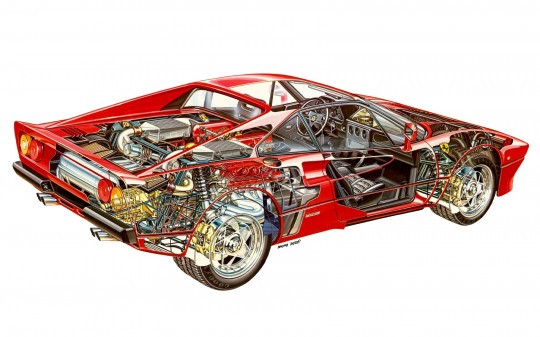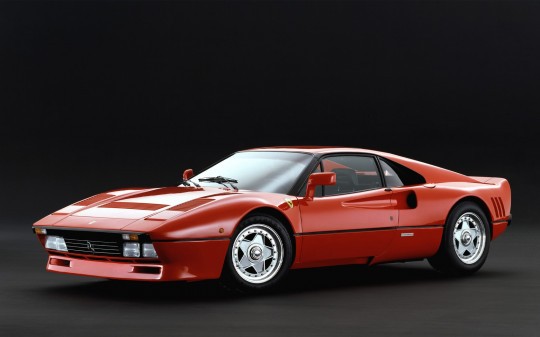Back in the early ‘80s, Ferrari’s road car sales began to go downhill. To revitalize the brand, designers and engineers decided to bring forced induction - which was gaining popularity in Formula One – to the brand's road cars. The result is one of the most epic Ferrari cars of all time, the 288 GTO (Gran Turismo Omologato).
A Short Story of How the Legendary Ferrari 288 GTO Was Developed
The exotic sports car, which was codenamed Type F114, entered development in 1983. At the time, Enzo Ferrari was fuming because sales of his cars were falling due to stronger competition and what he described as an "excessive gentrification" of the model lineup.
The plan was to create the ultimate sports car out of the mediocre 308 GTB/GTS models. The first attempt was the 208 Turbo, which was powered by a 2.0-liter turbocharged V8 that was notoriously unreliable, in part due to the lack of an intercooler.
Ferrari approached the head of powertrain development for the Gestione Sportiva (Racing Division), Nicola Materazzi, to develop a new 3.0-liter turbo unit that could produce 400 PS (395 bhp), eliminating reliability issues.
Before joining Ferrari, Materazzi worked on the Lancia LC2 Group C racing car, so he had experience working with small-displacement turbocharged engines.
The final product was a 2.8- liter DOHC V8 with 4 valves per cylinder. It used IHI-produced twin-turbochargers, air-to-air intercoolers made by German specialists Behr, and a Weber-Marelli fuel injection system.
The powerplant had a compression ratio of 7.6:1, and unlike its predecessor, the 288 GTO’s V8 was mounted longitudinally, in a mid-rear position with the five-speed racing transmission fitted to its rear.
The new engine called F114B could produce 400 PS (395 bhp; 294 kW) at 7,000 rpm and 496 Nm (366 lb-ft) of torque at 3,800 rpm.
It launched the 288 GTO from 0 to 60 mph (97 kph) in around 5 seconds on its way to a top speed of 189 mph (304 km/h). This figure made it one of the fastest street-legal production cars of its time.
A team from Pininfarina, lead by Leonardo Fioravanti, was tasked with designing the new supercar. To cut costs and reduce the development process, a modified version of the 308/328 was used. Still, it was extensively modified, so few details of the initial model were found on the production version of the new 288 GTO.
It featured bulging fender flares, larger front and rear spoilers, "flag-style" side mirrors, and four driving lights at the far sides of the grille that fundamentally distinguished it from its predecessor.
To honor the original 250 GTO, designers added slanted air vents to the rear fenders, which resemble those on the sides of the legendary classic. The rear wing design also takes inspiration from the 250 GTO's original wing.
To reduce weight, most of the body panels were made from fiberglass. Steel was only used for the doors, while the hood was made from Kevlar, and the roof from a combination of carbon-fiber and Kevlar.
Materazzi felt that the car was too good to only be used on public roads and that its full potential should be harnessed on track. He suggested returning to racing in the GT class, but the General Director at the time, Eugenio Alzati, only allowed engineers interested in the project to work outside of the Monday to Friday timetable.
After growling overtime work, the team assembled by Materazzi managed to complete the project and gave birth to the GTO Evoluzione, a 650 bhp Group B-compliant racecar.
Five production models and one prototype were built but due to suspension of the Group B Circuit series in 1986, the Evoluzione never got to enter an official FIA-sanctioned race. However, the car is credited as the inspiration for another legendary Ferrari, the F40.
The 288 GTO was produced in Maranello from 1984 to 1987 in 272 units, the last of which was gifted to F1 Champion Nikki Lauda by Enzo Ferrari himself.
The plan was to create the ultimate sports car out of the mediocre 308 GTB/GTS models. The first attempt was the 208 Turbo, which was powered by a 2.0-liter turbocharged V8 that was notoriously unreliable, in part due to the lack of an intercooler.
Ferrari approached the head of powertrain development for the Gestione Sportiva (Racing Division), Nicola Materazzi, to develop a new 3.0-liter turbo unit that could produce 400 PS (395 bhp), eliminating reliability issues.
Before joining Ferrari, Materazzi worked on the Lancia LC2 Group C racing car, so he had experience working with small-displacement turbocharged engines.
The final product was a 2.8- liter DOHC V8 with 4 valves per cylinder. It used IHI-produced twin-turbochargers, air-to-air intercoolers made by German specialists Behr, and a Weber-Marelli fuel injection system.
The powerplant had a compression ratio of 7.6:1, and unlike its predecessor, the 288 GTO’s V8 was mounted longitudinally, in a mid-rear position with the five-speed racing transmission fitted to its rear.
The new engine called F114B could produce 400 PS (395 bhp; 294 kW) at 7,000 rpm and 496 Nm (366 lb-ft) of torque at 3,800 rpm.
It launched the 288 GTO from 0 to 60 mph (97 kph) in around 5 seconds on its way to a top speed of 189 mph (304 km/h). This figure made it one of the fastest street-legal production cars of its time.
A team from Pininfarina, lead by Leonardo Fioravanti, was tasked with designing the new supercar. To cut costs and reduce the development process, a modified version of the 308/328 was used. Still, it was extensively modified, so few details of the initial model were found on the production version of the new 288 GTO.
It featured bulging fender flares, larger front and rear spoilers, "flag-style" side mirrors, and four driving lights at the far sides of the grille that fundamentally distinguished it from its predecessor.
To honor the original 250 GTO, designers added slanted air vents to the rear fenders, which resemble those on the sides of the legendary classic. The rear wing design also takes inspiration from the 250 GTO's original wing.
To reduce weight, most of the body panels were made from fiberglass. Steel was only used for the doors, while the hood was made from Kevlar, and the roof from a combination of carbon-fiber and Kevlar.
Materazzi felt that the car was too good to only be used on public roads and that its full potential should be harnessed on track. He suggested returning to racing in the GT class, but the General Director at the time, Eugenio Alzati, only allowed engineers interested in the project to work outside of the Monday to Friday timetable.
After growling overtime work, the team assembled by Materazzi managed to complete the project and gave birth to the GTO Evoluzione, a 650 bhp Group B-compliant racecar.
Five production models and one prototype were built but due to suspension of the Group B Circuit series in 1986, the Evoluzione never got to enter an official FIA-sanctioned race. However, the car is credited as the inspiration for another legendary Ferrari, the F40.
The 288 GTO was produced in Maranello from 1984 to 1987 in 272 units, the last of which was gifted to F1 Champion Nikki Lauda by Enzo Ferrari himself.











No comments:
Post a Comment